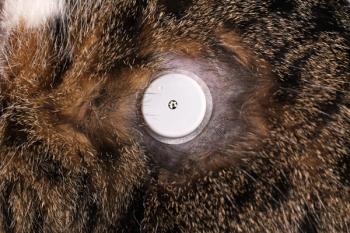
The endocrine system and how it relates to other organ systems (Proceedings)
During the past 35 years there has been a dramatic emergence of both experimental and clinically applicable information in the subspecialty of endocrinology. With the development of such invaluable laboratory methodologies as radioimmunoassay (RIA), thinlayer chromatography (TLC), enzyme-linked immunosorbent assay (ELISA) and equilibrium dialysis (especially valuable in the measurement of free/unbound circulating hormones (ie., FT4).
During the past 35 years there has been a dramatic emergence of both experimental and clinically applicable information in the subspecialty of endocrinology. With the development of such invaluable laboratory methodologies as radioimmunoassay (RIA), thinlayer chromatography (TLC), enzyme-linked immunosorbent assay (ELISA) and equilibrium dialysis (especially valuable in the measurement of free/unbound circulating hormones (ie., FT4). Hormones such as adrenocorticotropic hormone (ACTH), thyroid stimulating hormone (TSH) and gastrin, whose normal levels in canine and feline plasma/serum are so minute that they are measured in picomoles/milliliter (pmol/ml) can now can now be detected reliably. The development of monoclonal antibodies yields RIA results of incredible accuracy and specificity. Radioisotope imaging, CT and MRI scanning has enabled clinicians to detect various endocrine neoplasms prior to exploratory surgery.
Before the small animal clinician can confidently utilize such sophisticated diagnostic techniques, it is imperative that he or she has a firm understanding of the physiology and pathophysiology of the endocrine system.
Because living things have evolved from single-cell species to complex organisms, a system of organs to integrate the actions of the other organ systems and disseminate physiologic information from one region of the body to another was needed. The endocrine system acts as an overseer to maintain consistent function of all the other body systems. The maintainence of constancy within one's internal environment is termed HOMESTASIS.
The classic concept of the endocrine (Gr. endo-within; krinein to separate) system is a goup of organs that produce substances termed hormone (Gr. Hormeos I excite), which are secreted directly into the circulation instead of through a ductal system. Hormones are disseminated throughout the body and affect the function of other organs (target organs). Within this classic concept of endocrinology is the basic set of glands which are at its foundation (i.e., the pituitary, the thyroids, the parathyroids, the adrenals, the islets of Langerhands, the ovaries and the testes. The fact that most endocrine glands may continue to function quite adequately, even if transplanted to other regions of body, vividly illustrates the concept of ductless secretion of hormones. An exception to this concept is the pituitary gland, which derives its stimulation from hypothalamic releasing factors.
The latter portion of the 20th century revealed an expansion of our classic concept of the endocrine system. Various cell groups in the alimentary tract produce substances that evoke a hormonal response upon their target organs (the so-called APUD cells, which are embryologically derived form neural crest cells). The kidney functions as an endocrine gland with the secretion of 1, 25, dihroxycholecalciferiol, erythropoietin and rennin. The prostate gland, pancreas uterus and lungs contain ample concentrations of prostaglndins which have profound effects upon smooth muscle function, blood pressure, blood coagulation and the inflammatory process.
Chemically, hormones may be classified by their molecular composition (small peptides, large peptides amino acid derivatives, fatty acid derivatives and steroids). Knowledge of a hormone's chemical structure enables the clinician to determine the most accurate method to measure it (serum vs. plasma vs. urine; RIA vs. ELISA vs. equilibrium dialysis vs. thin layer chromatography).
Hormones modify cellular metabolic processes directly or indirectly. As a general rule the combination of a hormone with its receptor results in intracellular changes by one of two mechanisms 1) the emergence of a second messenger within the cell; or 2) the translocation of the hormone-receptor complex into the nucleus. Steroid hormones which are lipid soluble, diffuse freelythrough the cell membrane and exert their effects via the second mechanism. Catecholamines and polypeptides appear to affect their target organs via the first mechanism; which activates the intracellular enzyme, adenylate cyclase which reacts with ATP forming Cyclic AMP causing the altered cellular function.
The synthesis and release of a specific hormone must be strictly regulated (i.e., the endocrine gland must be both suppressible and also have the reserve capacity to secrete increased concentrations of the hormone to fulfill a physiologic need). An important basic principle of hormonal regulation is the negative feedback system This implies that if a supraphysiologic level of a certain hormone is present in the circulation, this will induce suppression of any further secretion of that hormone until its blood level decreases within its normal physiologic range (an example would be excessive levels of cortisol will produce a negative feedback upon the hypothalamus and adenohypophysis; suppressing the further release of CRF and ACTH, respectively
References
Drazner, FH: Small Animal Endocrinology Churchill Livingstone. 1984.
Drazner, FH: A Case Report of a Dog with Gastrinoma, Resembling the Zollinger-Ellison Syndrome. California Veterinarian. 1978.
Mooney, CT. and Peterson ME (eds) BSAVA Manual of Canine and Feline Endocrinology. BSAVA. 2004.
Monroe, WE: Disease of the Endocrine Pancreas and Pituitary Gland in: Leib MS. and Monroe WE. :(eds.) Practical Small Animal Internal Medicine, WB Saunders. 1997.
Newsletter
From exam room tips to practice management insights, get trusted veterinary news delivered straight to your inbox—subscribe to dvm360.




